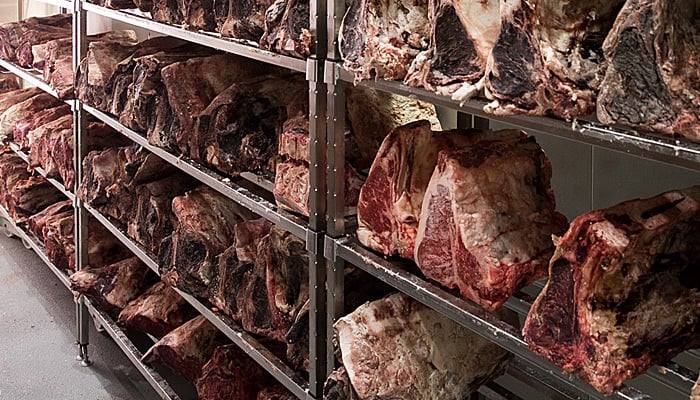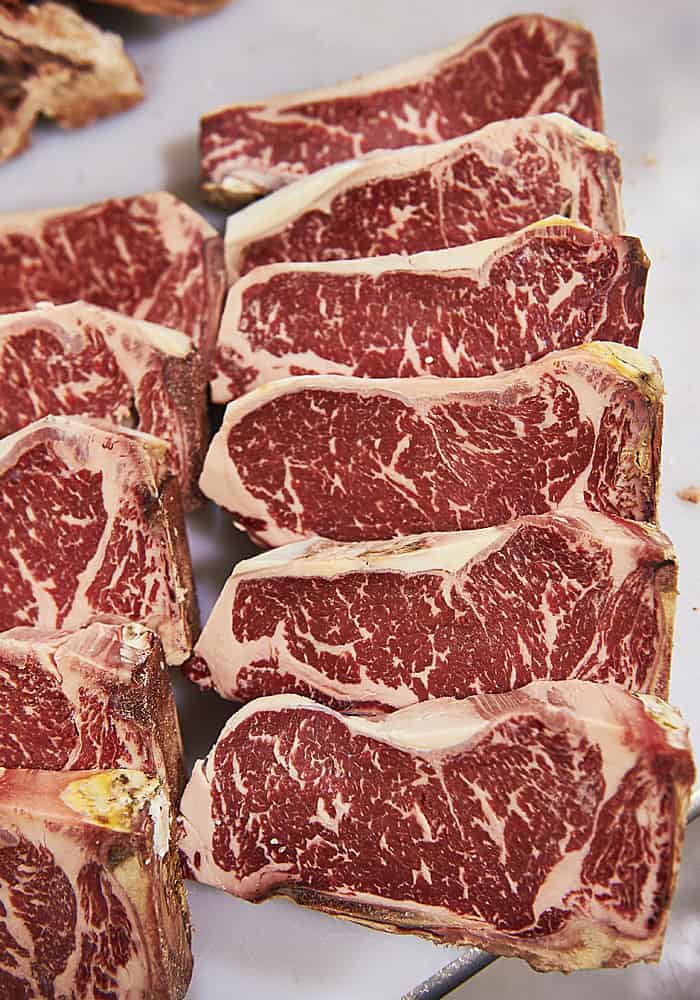Want to be supplied by the best? Make an enquiry

In the early parts of the 20th century, dry-aging was the norm. You’ve seen countless images of beef carcasses hanging around the edges of market stalls. Of course, as time went on, the production of dry-aged beef became more sanitary, and up until the 1970s it was the standard for aging meat. However, the introduction of vacuum sealed packaging and the more economical method of wet-aging took over for the next two decades. Like most trends, particularly in the food industry, we’re making the trip back to the slow way, the way it all started, with a special focus on the importance of process.
So, what exactly happens in the dry-aging process?
Why Dry-aged?

The dry-aging process itself entails storing the meat, either in primal or portioned cuts, in a refrigerated room (called a hot box) at temperatures near freezing, during which a fungal mould forms on the outside of the cut of beef, creating an external ‘crust’. This changes the beef in two ways; first, it causes a reduction of moisture in the muscles, intensifying the natural flavour of the meat, and secondly, the natural enzymes in the beef break down the muscles’ connective tissues, tenderising the cut.
Due to the actual nature of what dry-aging is (leaving raw meat to air for up to 6 weeks), only the highest quality cuts of beef are used for the process. Meat can be dry-aged for anywhere from 5 to 28 days.
At Haverick Meats, we’ve constructed our own in-house, temperature and humidity-controlled dry-aging room – an industry first in Australia. This requires meeting four key criteria:
- A completely controlled environment must be created where the dry-aged products are segregated from other products (including the wet-aged products)
- The dry-age room must have a constant, evenly distributed airflow which serves to gently encourage the drying process
- The humidity in the room is set to a specific level and kept constant throughout the aging period
- The temperature in the room is set to just above freezing and kept constant throughout the aging period
Thanks to our custom-built dry-aging facility, we’re able to offer our customers Haverick Certified Dry-Aged Beef™, hand-selected superior cuts of marbled, Angus-Hereford beef before being aged to their specification.
Generally, the dry-aging process takes a minimum of five weeks but can be up to nine weeks and as short as a few days for a very mild flavour.
The process
In the first week of the process, the environment inside the dry-age unit encourage the muscle proteins and collagen to begin to naturally break down. These release natural enzymes in the beef into the meat, causing a reaction in the amino acids of the muscle.
As time continues to pass into the second week, the amino acids and enzymes continue to tenderise the cuts and release flavour while the cut reduces in size and begin to take on a concave shape as it continues losing moisture.
Natural moisture in the muscle is pushed outward from the core, but fat and bone coverage on the top and sides of each cut serve as waterproof barriers, forcing the expelled moisture to exit the muscle through the front and back. Each cut will lose up to 15% of its moisture in the first three weeks of dry-aging.
By the fourth week, the meat has significantly changed flavour, thanks to the work of the enzymes. At this stage in the process, the flavour of the beef is very strong and distinct, the cut will have drastically reduced in size and darkened in colour.
Once the process is finished, the cut will be nearly one-third its original mass. In preparation for delivery to customers, the outer crust is trimmed to reveal a succulent, deep red, flavoursome cut of beef.
At Haverick, our standard aging period is six weeks, but as with all of our products, we’re happy to work with our customers to create something just for them. Our capabilities for dry-aging don’t stop at beef either, we’re currently dry-aging whole ducks, pork cutlet and bone-in Berkshire whole pork racks. We’ve also worked closely with Chur Burger to integrate our dry-aged beef into one of their burger mince recipes, offering a rich, buttery, nutty flavour to the patty.
For us, dry-aging meat is a passion as beautiful as aging a fine cheese or wine.
